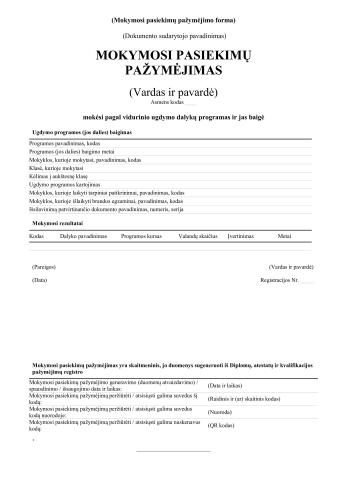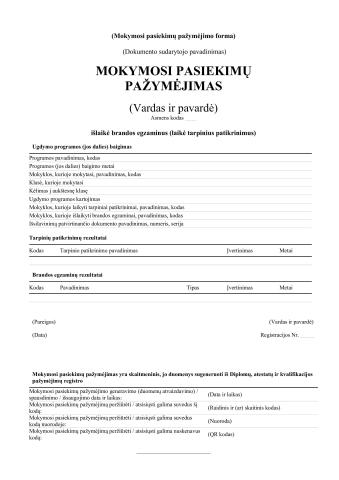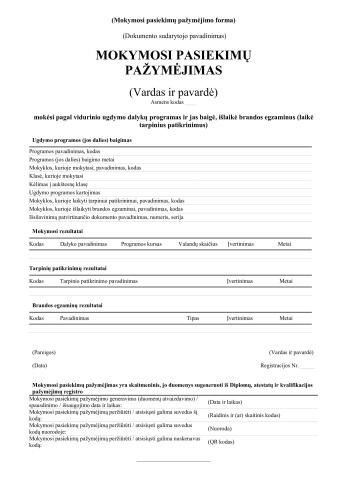Address
Nacionalinė Švietimo Agentūra
The National Agency for Education
Eurydice Unit
K. Kalinausko str. 7
LT-03107, Vilnius
Tel: +370 658 18124
E-Mail: info@nsa.smm.lt
Website
Pupil/Students assessment
Procedure for assessing pupil achievements and progress
Assessment of pupils' learning achievements and progress is part of the content of school education. It must be consistent with the educational objectives. The school, in accordance with the legislation and school agreements, develops its own Description of the procedure for assessing the achievements and progress of the school pupils. The director approves it and publishes on the school's website.
According to the Description of Primary, Lower Secondary and Upper Secondary Education Curriculum approved by the Minister of Education, Science and Sport, the school decides on:
- Methods and tools used to assess or/and evaluate pupils’ achievements and progress. The school decides whether it will use: marks (ten-point evaluation system), comments, cumulative points, folder (e-portfolio, e-folder), descriptions of learning achievements, pupil’s characteristics, pupil’s success stories, (self-) assessment, descriptive evaluation, etc.
- Evaluation methods for studying subjects, chosen subjects, subjects modules. For example, if a student in an upper secondary education program intends to choose a degree in sport, it is suggested that the learning achievement in physical education be evaluated using marks and not a record.
- Conversion of assessment to a ten-point system. If a teacher is not using a ten-point system to evaluate pupils’ achievements, the school establishes the time by which the assessment must be converted to a ten-point system. It is not necessary to convert achievements if the pupil is evaluated by “credited”/“not credited”.
- Ensuring consistency between forms of student achievement and progress assessment.
Provisions and types of assessment
The assessment of pupils’ achievements and progress covers a range of objectives:
- For the pupils: to support the learning of pupils by providing feedback about their achievements and progress and to enable them to analyse their learning and make decisions concerning further education.
- For the teachers: to understand, record and evaluate the achievements attained by the pupil and verify their level as described in the general curriculum; to support justified decisions in the planning and improvement of further education; to create a favourable environment for education by considering the changing needs of pupils; and to purposefully use the information on the pupil’s achievements and progress, while cooperating with their family and other participants in the education process.
- For the child’s statutory representatives: to find out the progress made by the child; to receive information about their achievement level and how best to help them learn.
- For school principals: to monitor the pupils’ learning progress and achievements, to analyse them and decide how best to assist teachers and pupils, and to promote an assessment and self-assessment culture at school.
- For school owners: to provide assistance to teachers and schools striving for better learning outcomes and the progress of their pupils.
- For education policymakers: to use the assessment information for monitoring purposes and also to contribute to national progress indicators for the evaluation and forecasting of the overall state of the education system and to support improvements.
Assessment provisions:
- Pupils’ achievements are to be assessed using the achievement level descriptions and the achievements specified in the general curricula.
- Assessment should be relevant to the pupils and assist with individual progress.
- There needs to be a shift towards a personalised assessment culture and away from the uniform-for-all assessment culture.
- Formative assessment will be applied to promote the monitoring and assessment of an individual’s progress, whereas summative assessment should be used for evaluating the learning outcomes.
- Assessment should include a minimum of several sources of evidence, include diverse assessment methods, and provide accumulated and summarised proof of achievements.
- Assessment results should be shared with the child’s statutory representatives and become a regular process included in the child’s learning.
- A pupil’s participation in the assessment process is important; the pupils themselves, should assess their learning process and outcomes.
When implementing the general curricula, the following assessment methods should be used:
- Formative assessment – feedback is provided during the education process to promote, track and assess a pupil’s progress. The aim is to improve their learning outcomes while also directing them towards things yet to be learned. The teacher can choose the most effective education methods, while striving for the best results possible. Assessment of the current situation is one of the components of formative assessment. It helps the teacher to understand what the pupils already know and are able to do, and how to plan for further educational input. Formative assessment is not tied to grading; it provides data for the teacher on which to base qualitative feedback to the pupil regarding their next learning steps.
- Self-assessment – pupils are required to monitor, assess and reflect on their learning process, their achievements and progress, while also anticipating their next learning steps.
- Summative assessment – this is used to verify the pupil’s achievements upon completion of a topic, section, course, module, or curriculum. In pre-school education, summative assessment is used to evaluate a child’s achievements upon completion of the curriculum. Interim assessment might also be used as appropriate. In primary, lower, and upper secondary education, summative assessment allows constructive education goals to be set and the (self) selection of the appropriate methods of teaching and learning as well as the provision of proof of learning outcomes to pupils, and their statutory representatives, and/or parents. Internal summative assessment is used by the teachers to sum up a pupil’s learning outcomes and record their results using a grade or other format. External summative assessment ensures reliable data-based feedback within the education process. This also offers the possibility to inform the community on a countrywide basis regarding the level of success achieved against the national education objectives. External summative assessment is also used to verify the pupils’ achievements upon completion of primary, lower, and upper secondary education curricula.
- The alignment of self-assessment and formative and summative assessment is ensured by the teachers and school principals exercising their responsibility, an inclusive assessment culture in the schools, and a dialogue among all parties associated with education.
In the general curricula of primary, lower, and upper secondary education, threshold, satisfactory, basic and advanced levels of achievement have been defined. In the primary education curriculum, achievement levels and assessment portfolios are used to record the progress and achievements of pupils and to provide assessment information. Pupils learn to build these portfolios assisted by the teacher, while simultaneously learning to self-assess. Pupils’ accomplishments are not graded. In the lower and upper secondary education curricula, achievement levels are tied to grading: threshold – 4 points, satisfactory – 5–6 points, basic – 7–8 points, and advanced– 9–10 points.
All organised examinations are state-level examinations. Differentiated general and extended course tasks are provided for the Lithuanian language and literature Matura examination as well as the mathematics Matura examination. Other examinations are held according to the extended course requirements. All state-level Matura examinations are comprised of two parts. The pupils take the first part, representing 40 points (except for the Lithuanian language and literature Matura examination, where this part represents 30 points), during the first year of study within the secondary education curriculum (form III of the gymnasium), and they take the second part of the examination, accounting for 60 points (except for the Lithuanian language and literature Matura examination, where this part represents 70 points), upon the completion of learning under the secondary education curriculum (after form IV of the gymnasium). The first part of the examination is organised electronically, and the pupils complete the tasks on the computer, while the second part is completed in person, and in writing.
The result of the state-level Matura examinations equals the sum of the results of part one and part two of the state-level Matura examination. Both parts of the examination are compulsory.
The state-level Matura examination is deemed to have been passed if the pupil achieves a total of 35 points out of a possible 100 points for the combined parts one and two of the examination in a given subject. The final evaluation of the examination that is entered into the certificate is presented on a scale from 40 to 100 points.
Participants in assessment
Learning achievements are evaluated by teachers, education providers, school founders, the Ministry of Education, Science and Sport and its authorised institutions.
Teachers plan and assess their pupils progress and learning achievements. They sum up and evaluate each pupil’s academic attainment. They record the assessment results in the manner established by the school; provide information about performance, achievements and gaps in their knowledge to the pupils, their parents (guardians, caregivers), other teachers and the school administration. Analyse and adjust the pupils’ teaching and learning. And, finally, teachers ensure that pupils experiencing learning difficulties are provided with timely assistance.
The school determines the general procedure for collecting, recording and using information about pupil assessment. It ensures consistent application of assessment methods in the progression of a pupil from one class to another or from a lower stage of education to a higher one and among parallel classes or separate subjects. The school also coordinates the scope and frequency of tests. It provides assistance to pupils experiencing learning difficulties. And last but not least, it evaluates the quality of work performed by individual teachers and the school by pupils’ attainment.
The education department of the school founder administration analyses the information about pupil assessments that it receives from schools and uses it for decision-making. It also takes the social and cultural context into account when making judgements about the efficiency of the school activities. It ensures that the procedure for external assessment of pupils’ attainment should be agreed with the school and its teachers. And, finally, it creates conditions for teachers’ professional development.
The Ministry of Education, Science and Sport approves documents regulating the general content of formal education and pupil assessment. It determines the pupil assessment procedure at the time when the pupil completes the upper secondary education programmes. It also ensures timely analysis of pupil assessment results and their presentation to the pedagogical community and the general public and also the efficient use of that information.
Progression of pupils/students
Transfer to the next grade
A pupil of grade 11 whose year-end scores in all compulsory subjects are satisfactory is transferred to the next grade.
Upon completion of the school year, a final year pupil who has unsatisfactory year-end assessments or has failed in some credits or examinations is not allowed to repeat the year. He/she can eliminate the debts by learning independently at any school implementing the corresponding upper secondary education programme.
Matura examinations
For a pupil to be awarded a certificate of secondary education, upon completion of the secondary education curriculum, they must take state-level Matura examinations. Two state-level Matura examinations have to be passed in order to be awarded the certificate. In this case, a state-level Matura examination in Lithuanian language and literature according to the general or extended course is obligatory.
State-level Matura examination (SLME) – an examination prepared in accordance with the structure and requirements as defined in the general curricula, that is held at the state-level examination centres. The assessment of the completed examination papers is centralised.
In Lithuania, in 2013, the assessment of SLME papers was changed. Previously, the assessment of SLME papers was normative with criterial assessment elements. Pupils who passed the SLME used to be graded on a scale from 1 to 100 points. However, since 2013, SLME tasks and their assessment are of criterial character. Based on criterial assessment principles, the result for a pupil taking the examination is ascribed to a pre-determined SLME achievement level. As of the academic year 2024–2025, following an update of the general curricula, SLME results are ascribed to threshold, satisfactory, basic or advanced achievement levels, where 40 points correspond to the threshold level, 41–49 points – the satisfactory level, 50–85 points – the basic level, and 86–100 points represent the advanced achievement level.
Permission to take a Matura examination
A pupil who has completed the upper secondary education programme of a subject and has a satisfactory year-end assessment in it is allowed to take a Matura examination in that subject. The school principal approves by an order this permission. A pupil who has an unsatisfactory year-end assessment is not allowed to take an examination in that subject.
An individual who receives an unsatisfactory score during the main session of the national Matura examinations is allowed to take a school Matura examination in the same subject during a repeat session.
The institutions authorised by the Minister for Education, Science and Sport administer examinations and commission learning achievements assessment in other ways.
Certification
A pupil who has satisfactory year-end scores in each subject in the final year is considered to have completed the upper secondary education programme.
A pupil who has passed the Matura examinations is considered to have acquired upper secondary education. The year of completing the programme and acquiring upper secondary education do not necessarily coincide.
A certificate of learning achievements is issued to a school graduate who did not take the Matura examinations or passed only some of the examinations and/or credit tests required for the Matura certificate.This digital document from 2023 May 1st it is also issued to a person who has the Matura certificate or other document confirming secondary education and who has repeatedly and/or additionally passed the Matura examination and/or additionally or repeatedly studied according to the subject's general program and completed it.
Matura certificate is awarded to a pupil who has completed the upper secondary education programme and has passed Matura examinations. In order to obtain a Matura certificate a pupil must pass two Matura examinations (except for cases when a candidate is exempted from the selected Matura examination by an order of the school principal).
For certification to be granted, one of the examinations is compulsory – the Lithuanian language and literature according to the general or extended course. In addition to the Matura examination in Lithuanian language and literature, pupils may choose and take an unlimited number of Matura examinations in various subjects. From 2016, all those willing to study in state-funded study programmes take the Matura examination in mathematics (with the exception of those entering Arts studies). From the academic year 2024–2025, two types of state-level Matura examinations in mathematics are organised according to the general and extended course.
The Matura certificate with honours is awarded to a pupil who who has at least 9 points in the annual and school Matura examinations, who has passed the state Matura examination in at least one subject and has at least 86 points in all the state Matura examinations.
The Matura certificate is issued to pupils from state, municipal and private schools, vocational education and training schools, who have completed general upper secondary education, adult secondary education, secondary education with engineering education programme, secondary education with sports education programme, secondary education with music education programme, secondary education with art education programme, secondary education with artistic education programme.
From 1 May 2023, digital certificates, including maturity certificates, are issued in Lithuania. General education certificates and maturity certificates are issued in the Republic of Lithuania according to the Order of the Minister of Education, Science and Sport On the Approval of the Procedure for the Issuance of Certificates and Maturity Certificates.
Digital (electronic) certificates and maturity certificates are prepared based on the information system tools of the Register of School Pupils and the Register of Diplomas, Certificates and Qualifications, and are accessible (can be viewed, downloaded from an email and/or printed) in the the Register of Diplomas, Certificates and Qualifications.
Certificates and maturity certificates are deemed to have been issued when they are registered in the Register of Diplomas, Certificates and Qualifications (by allocating a registration number) after the school prepares such certificates. The school principal certifies the transfer of the data/records to the register with his electronic signature and is responsible for the accuracy of the data/records in the certificates and maturity certificates.
A numerical code and a QR code are specified in the last table in the certificate and the maturity certificate. The school may provide this code to the pupil if the pupil cannot access the Electronic Government Gateway to download (or view) their certificate and/or maturity certificate. Other persons, national and foreign authorities, may check the fact of issuance of the certificate, the authenticity of the data, etc. by using the code and/or QR code with the consent of the owner of the certificate or maturity certificate (login link: https://www.dakpr.smm.lt/aikos2-dakpr/edocSearch.xhtml) in accordance with legal acts for ensuring the security of personal data.
More information on how to issue digital certificates and maturity certificates, how to download, view or print the certificates and/or maturity certificates, etc. for students and their parents/foster parents/guardians by logging into the information system of the Register of Diplomas, Certificates and Qualifications is available on the website of the National Agency for Education.
Form of Matura certificate issued from 2023-05-01 to 2024-05-14
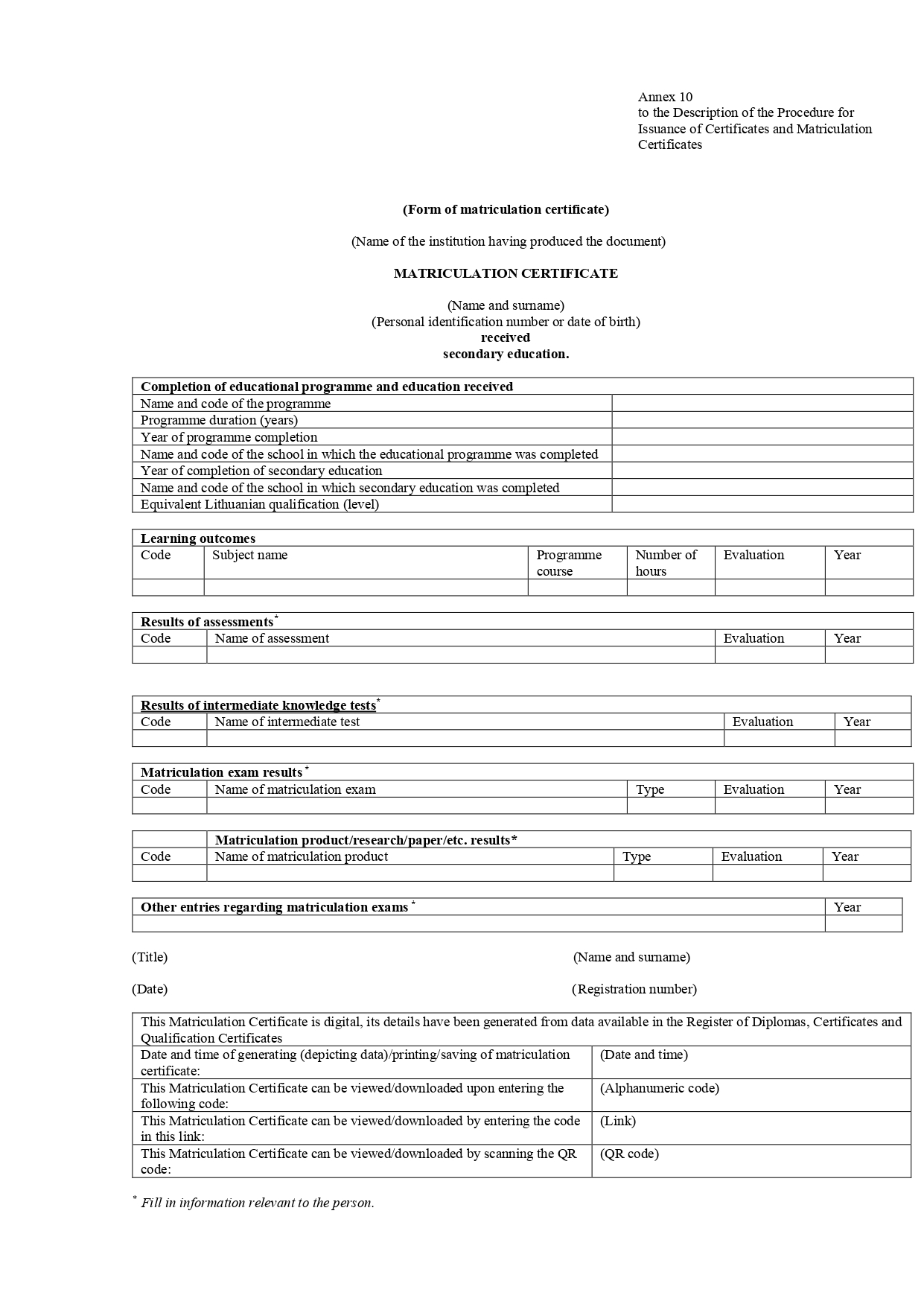
From 2024, Lithuanian school graduates who pass the matriculation examinations will receive a digital Matriculation Certificate in Lithuanian and English. This is enshrined in the amended Procedure for the Issuance of Certificates and Matriculation Certificates which will enter into force on 15 May 2024.
The Matriculation Certificates can be accessed (viewed, downloaded and printed) at the Register of Diplomas, Certificates and Qualifications. Certificates are deemed to have been issued when registered in the Register of Diplomas, Certificates and Qualifications (by allocating a registration number) after the school prepares such certificates.
To have the Matriculation Certificate approved by a notary public, it must be first downloaded and printed from the Register of Diplomas, Certificates and Qualifications and signed by the school principal, either by hand or electronically, and stamped with the school seal. Afterwards, a notary public certifies the Matriculation Certificate by issuing the Apostille.
The amended Procedure has also changed the form of the certificate of learning achievement issued to a person holding the Matriculation Certificate who has additionally taken or retaken the Matriculation Exams (to obtain a higher score) and/or completed the specific subject course (to obtain a higher annual evaluation).
Bilingual Matriculation Certificate form
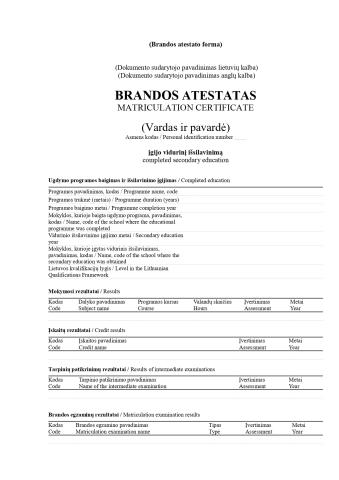
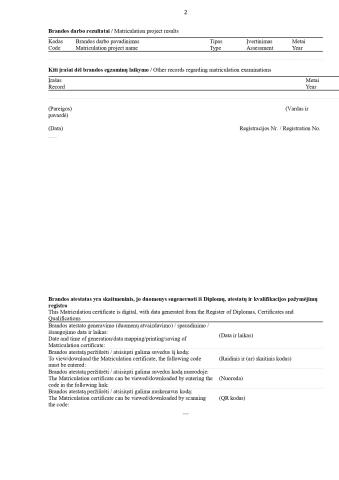
Form of the Certificate of Learning Achievement
